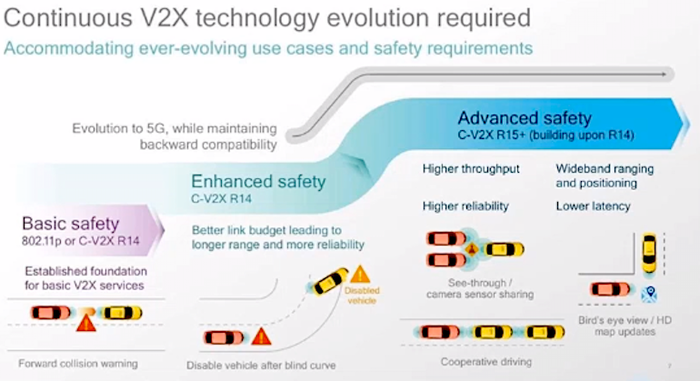EMC and RF interoperability for ADAS vehicles may challenge existing testing labs.
August 4, 2021

Advanced Driver Assistance Systems (ADAS) and Automated Driving Systems (ADS) collectively form some of the most challenging electromagnetic compatibilities (EMC) test scenarios. One reason is that they extend connectivity across multiple platforms. Additionally, this connectivity occurs across several vehicle platforms, e.g., individuals using wearables and fixed installations, base stations, and other bits of fixed communication infrastructures.
The question is how best to test the features built into modern vehicles, both in EMC performance and over-the-air communication. The testing infrastructure and the whole testing landscape are changing, and those changes should prove useful to the overall EMC testing world.
The topic of ADAS and ADS EMC testing was the focus of an IEEE IMS 2021 industry talk by Garth D’Abreu, Director of Automotive Solutions at ETS-Lindgren, and Ram Mirwani, Director for Global Business Development at Konrad technologies. What follows is a summary of that presentation.
Automotive EMC
EMC standard test environments have developed over the years to protect the RF infrastructure. Different bodies manage them in different countries, but there are a core series of international standards used in the automotive industry. These standards are geared to testing the onboard electronics in current RF environments and to ensure any emissions are low enough to prevent interference from other nearby receivers, e.g., from radios, televisions, and cellular infrastructures. (Image Source: IMS2021, D’Abreu, Mirwani)

With the increasing use of ADS features on modern vehicles, it's become necessary to adapt testing to include these new modules. Several testing facilities are looking to adapt existing test facilities to support some of these extended ADS tests.
Emission measurements of full vehicles are often performed in an anechoic chamber. During these measurements, the car is placed in a drive state running on a chassis dynamometer to simulate real driving conditions. The car’s onboard electronics are operating as normal to ensure tested devices are not radiating or emitting excessive levels across the usable frequency spectrum.
A converse test is also performed to ensure that the vehicle's systems can operate in a known and controlled RF environment. Such a test has become necessary as some ADS functions like braking and accelerating are deliberately controlled and adversely affected by RF signals.
Additional testing measures are needed to ensure that ADS vehicles can operate safely in today's RF environment. These additional requirements also impact existing hardware-in-the-loop (HIL) and vehicle-in-the-loop (VIL) testing. Taken together, these changes represent a definite shift away from protecting the RF spectrum towards making sure that critical car features can operate safely under today’s RF test conditions.
Most automotive manufacturers use several different sensors to support these tests, i.e., defining and sensing the environment within and without the vehicle. The combined sensor data will then be used to decide what that vehicle does in an operational setting. These sensors include ultrasonic devices, radar cameras, and LIDAR sensors. Modern test facilities may need to be updated to handle data from these types of sensors.
V2I and V2V
ADAS manufacturers have developed automated over-the-air, vehicle-to-infrastructure (V2I), and vehicle-to-vehicle (V2V) network systems so vehicles can “see” beyond their field of view using RF links. For example, one car can communicate with another car within its line of sight or outside of this line of sight to exchange relevant information. In this way, both vehicles will know precisely what the other vehicle is doing.
There are already several different standardized scenarios that have been defined that use V2I and V2V communications. These scenarios must also be included as part of any ADS testing regimes.
When it comes to RF testing and EMC testing specifically, there has been an increase in the frequency range of interest. Whereas traditional EMC tests were done from 150 kilohertz (kHz) to 1 gigahertz (GHz), recent tests have been expanded to 2.5 GHz.
There are even communication infrastructures that use frequencies beyond these upper limits. For example, DSRC and Wi-Fi links can now operate up to 5.9 gigahertz. There are radar modules that operate up to 24, 79, and even at 81 GHz gigahertz band, all of which are in current production vehicles.
This means that validation of operation tests will be needed to ensure that the test facilities can manage the performance of these systems across this broad range of frequencies. Operational items should include air communication links, the performance of the antenna, the transmitter, and the receiver.

John Blyler is a Design News senior editor, covering the electronics and advanced manufacturing spaces. With a BS in Engineering Physics and an MS in Electrical Engineering, he has years of hardware-software-network systems experience as an editor and engineer within the advanced manufacturing, IoT and semiconductor industries. John has co-authored books related to system engineering and electronics for IEEE, Wiley, and Elsevier.
About the Author(s)
You May Also Like





